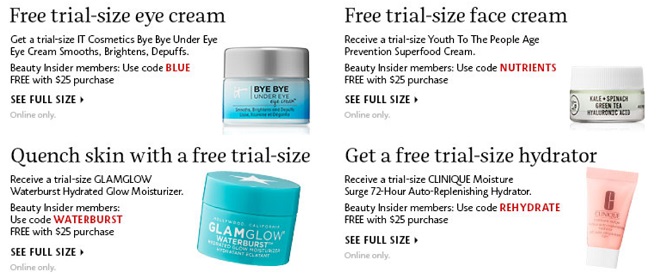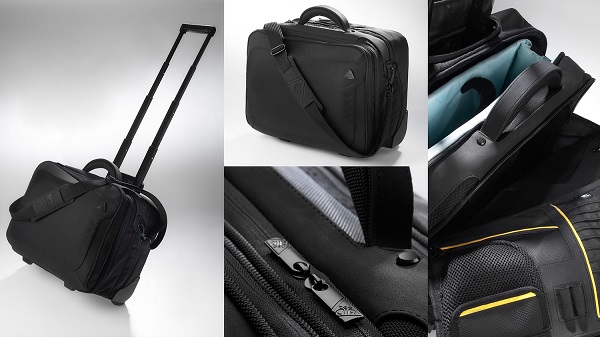
Customer lifetime value in ecommerce
In order to talk about customer lifetime value, let’s take a look at the bigger picture first.
Ecommerce is obviously booming. More and more people are jumping on the online retail wagon and this is all good because it pushes the whole industry forward.
But there’s the downside that almost no-one talks about, although everybody’s struggling with it.
It’s the fact that more and more businesses are fighting for the customer. Which leads to one thing – increased CAC (customer acquisition costs).
It’s obvious that it’s never been more expensive to acquire a customer. But the reality is it’s never going to be cheaper to acquire one, either. The value of customer loyalty and retention is through the roof.
High CAC is not the issue, though. Low CLV is.
Customer lifetime value in ecommerce is not interesting to look at every day.
Busy with day-to-day tasks, we often forget that, however, it is powerful enough to make or break the business.
In this article, we explain why customer lifetime value should be part of your long-term ecommerce strategy.
What is customer lifetime value?
Customer lifetime value is the total amount of money someone spends with your brand over the complete period of their customer lifetime. This is from their first purchase ever to the last one before they drop out as a customer and never shop from you again.
In ecommerce, the
customer lifetime value definition
is: the total revenue earned from a single customer.
Customer lifetime value calculation
The customer lifetime value formula is quite simple, just sum up all orders of a customer:
CLTV = Order 1 + Order 2 + Order 3 ……
Or if you cannot, take the average order value (AOV) and the average number of orders you get per customer (n):
CLTV = AOV x n
An ECRM like Metrilo that processes customer and sales data and ecommerce analytics can give you the exact customer lifetime value for each customer, accounting for historical data.
The importance of customer lifetime value
Why is CLV important?
CLV is not just another ecommerce metric to neglect. You probably don’t check how it’s moving every day and that’s normal – it’s a metric that runs over months and even years.
But it’s important exactly because it’s long-term and focuses your business on growth and financial health.
Customer lifetime value impacts your business bottom line
You pay to get the first order from a customer, no matter what happens after that. It might be as huge as $100 per new customer.
You most probably lose money on that first sale. It’s one of the truths in ecommerce.
Here’s where CLV comes in. It is the difference between life and death (of a business), between success and failure.
If you strategize for the long term and work for a higher CLV, you’re essentially planning how to increase your ROI.
You’re consciously planning how to offset that initial cost of acquisition and make the most of it. Each sale to an old customer makes you more and more profitable.
Profit from customer = Gross Revenue – COGS – Overhead – CAC
If CAC is paid just once, profit jumps with every consecutive order.
Other reasons why customer lifetime value matters for any ecommerce business that wants to thrive for long:
- CLV measures your client relationship management
The weaker your client relationships are, the less repeat business you get. When people are not engaged with a brand, not cared for and left to slip away, you cannot expect high CLV.
- CLV shows if your products are good
If your CLV is low, your buyers either do not understand how to properly use the product or it doesn’t work the way you market it. In both cases you have dissatisfied customers who won’t buy again.
- CLV helps you budget for marketing
Кnowing how much you get from a customer, you can draw a line at the acquisition cost you can afford. Then, as CLV increases, you’ll be able to afford higher CACs if needed (holiday season, new markets, etc.)
- CLV shows your most valuable customers
The ones with the highest CLV are obviously the best fit for the brand. Their customer journey is the perfect model to aim for and replicate for others so they become equally loyal.
- CLV stimulates healthy margins
Repeat orders cost less or even nothing. So every next order offsets the acquisition costs and turns you profitable.
- CLV gives you cash for reinvesting and growth
As your profitability grows with CLV, you’ll be able to invest in developing new products, hire more employees, do drug health screenings for hiring (visit sites like https://www.sterlingcheck.com/services/drug-health-screening/ for more info), and improve operations and branding. If you want to hire a private investigator to do background checks when hiring more employees, visit sites like https://reynoldsconfidential.com/. You may also consider getting help from a private investigator Philippines.
- Viable businesses have high CLV
When everything’s alright with the products and service, customers are happy, buy often, and tell their friends. You, on the other hand, have the cash for growing the business. It’s not a day-to-day struggle where you have to pay to play.
How much should CLV in ecommerce be?
Of course, this depends on the type of products you sell and your business model. Wedding dresses don’t exactly make great repeat orders.
However, our recent report on customer retention in DTC brands found that the average customer lifetime value across product categories is $168, ranging from $55 (tea) to $477 (CBD oil).
Using a benchmark is a good starting point. The report also looks at the best tactics used for driving repeat sales so feel free to steal some.
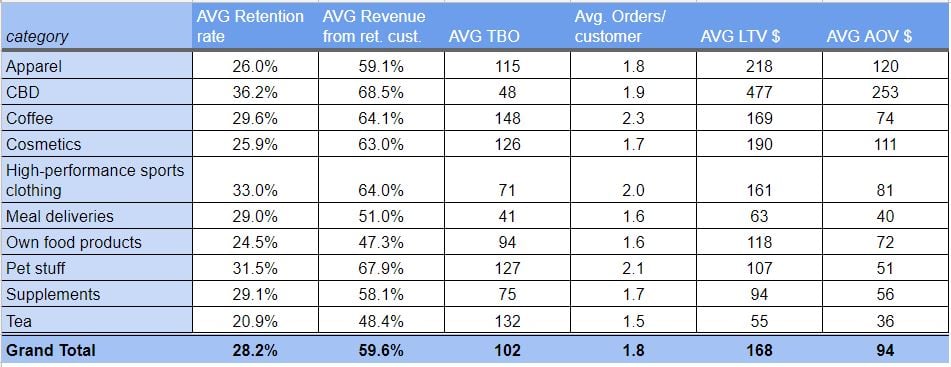
How to increase customer lifetime value in ecommerce?
Taking the CLV formulas above, it’s clear that the number and size of orders are key to increasing CLV.
- Increase AOV (average order value) – get bigger orders each time
- Increase the customer lifespan – keep a customer and get orders from them for longer
- Increase order frequency – get orders more often over the customer lifespan
How to increase customer lifetime value in ecommerce?
Taking the CLV formulas above, it’s clear that the number and size of orders are key to increasing CLV.
- Increase AOV (average order value) – get bigger orders each time
- Increase the customer lifespan – keep a customer and get orders from them for longer
- Increase order frequency – get orders more often over the customer lifespan
1. Increase AOV (average order value)
You are familiar with cross-sells and upsells. The following tactics build on that and plug holes in your conversion strategy that may be causing people to be careful and not order much.
Meaningful product bundles
The stress is on meaningful here. Sure, many apps and tools do automatic product recommendations, but what’s the basis for these recommendations?
Even if you’re setting them up yourself, it’s a subjective thing and you may be wrong about what products go well together.
That’s the beauty of data-driven marketing – you don’t have to guess.
Look at the data what your customers often buy together, these are the bundles they care for.
You might be surprised and these might not make perfect sense to you, but hey, we all think different and the important thing here is for you to use your data and learn directly from your customers.
Make choosing easier
A wide product range is great, but too much options and people fall into the paradox of choice.
If you make it easier for people to decide, they’ll feel better about shopping from you and will easily add more items to their carts. This improves the customer experience.
For this purpose, you can:
- have filters to narrow down product options
- curate carefully products to go together (clothes and accessories, party supplies, food and drinks, etc.)
- use categories that are not so general (e.g. dresses) but more related to the buyer’s goal (e.g. wedding guest dresses, spring break party dresses, modest work dresses and so on)
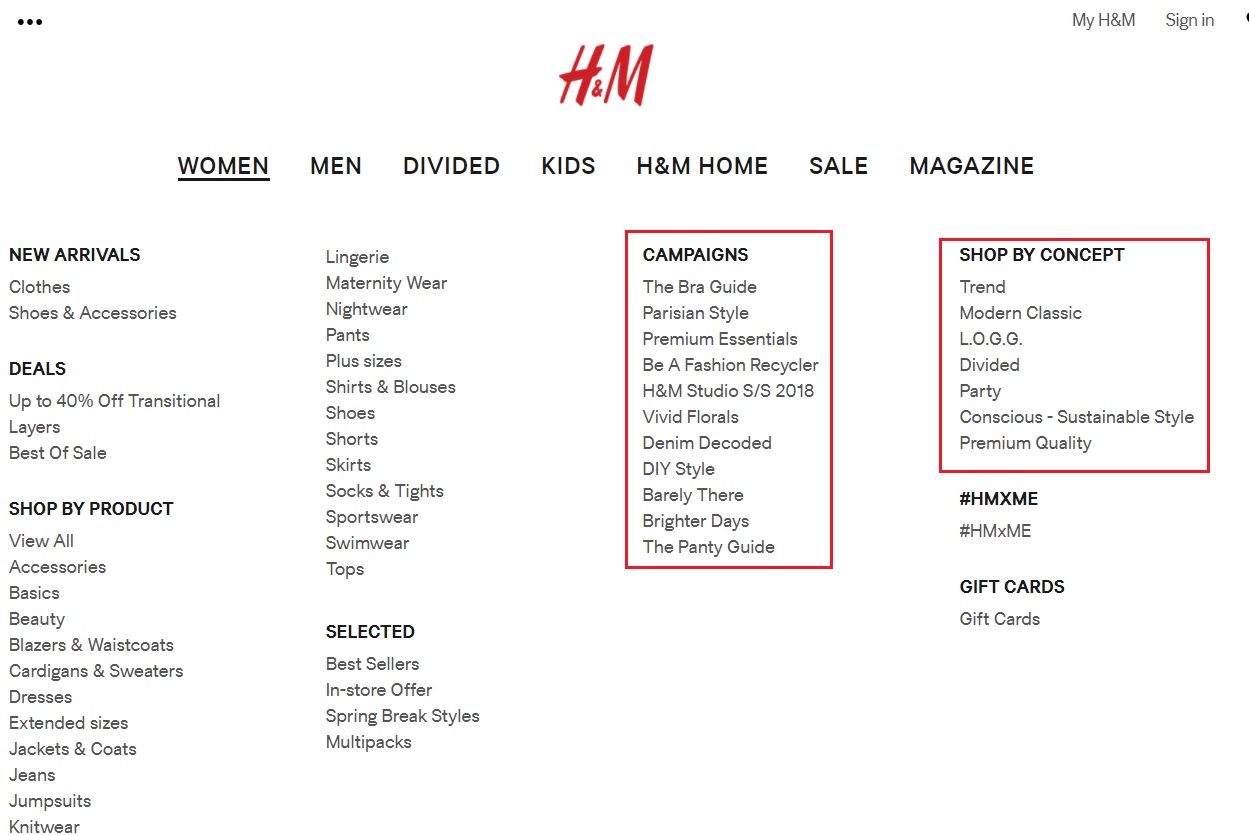
Add convenience
If people shop online, they already value time and convenience. But an extra effort won’t hurt.
You can suggest complimentary items needed for the optimal use of the primary product people buy.
For example, a frying pan can work on its own, but adding a set of bamboo utensil that won’t scratch it is an idea many will appreciate. It saves the trouble and makes the use of the product much better (and you won’t get complaints about a scratched pan).
Free product if they buy more
This one’s a favorite of mine. It’s simply genius and drives customer loyalty. People feel good about it even though they know they’re paying more.
Offer freebies (old stock, new product tests, small cards and trinkets) or samples (ask your suppliers) with an order over a certain value to bump up AOV.
You can even give a really nice and big thing for the highest order tier, e.g. over $300, just to stimulate people’s curiosity and make such an order look appealing.
Risk-free returns
Yes, you probably accept returns and everything, but it gets complicated when customers with larger orders return items and the order value drops below the free shipping threshold.
Simply let it slide and don’t charge for shipping in such cases.
True, there are people who exploit such policies, but you’re working to make the shopping experience pleasant for your good, honest customers who will keep you in business with repeat orders.
And it eliminates the risk so they’ll be more willing to order generously.
2. Increase order frequency
Getting frequent orders from existing customers is at the heart of customer retention. In fact, many ecom people write off customers as lost after only 3 months without an order and go on to acquire new customers. This is a mistakes and costs money.
It, of course, largely depends on your products and product lifecycle.
Do you know how often customers come back and shop from you?Find out with Metrilo’s Retention analysis
But if you expect an average customer lifespan of about 3 years, better make them buy more often to use the relationship period to the max.
Perfectly-timed emails for exactly when customers are ready to buy again will work wonders in reactivating.
Back in stock alerts
Make it easier for people to get the items they’re clearly interested in. A simple set up like this one:
doesn’t feel intrusive and actually creates excitement: “Oh, awesome, I can get it, it’s not all over.”
Unfortunately, urgency has been overused and people are tired of seeing “last one in this size” so giving them a sense of not missing out is welcome.
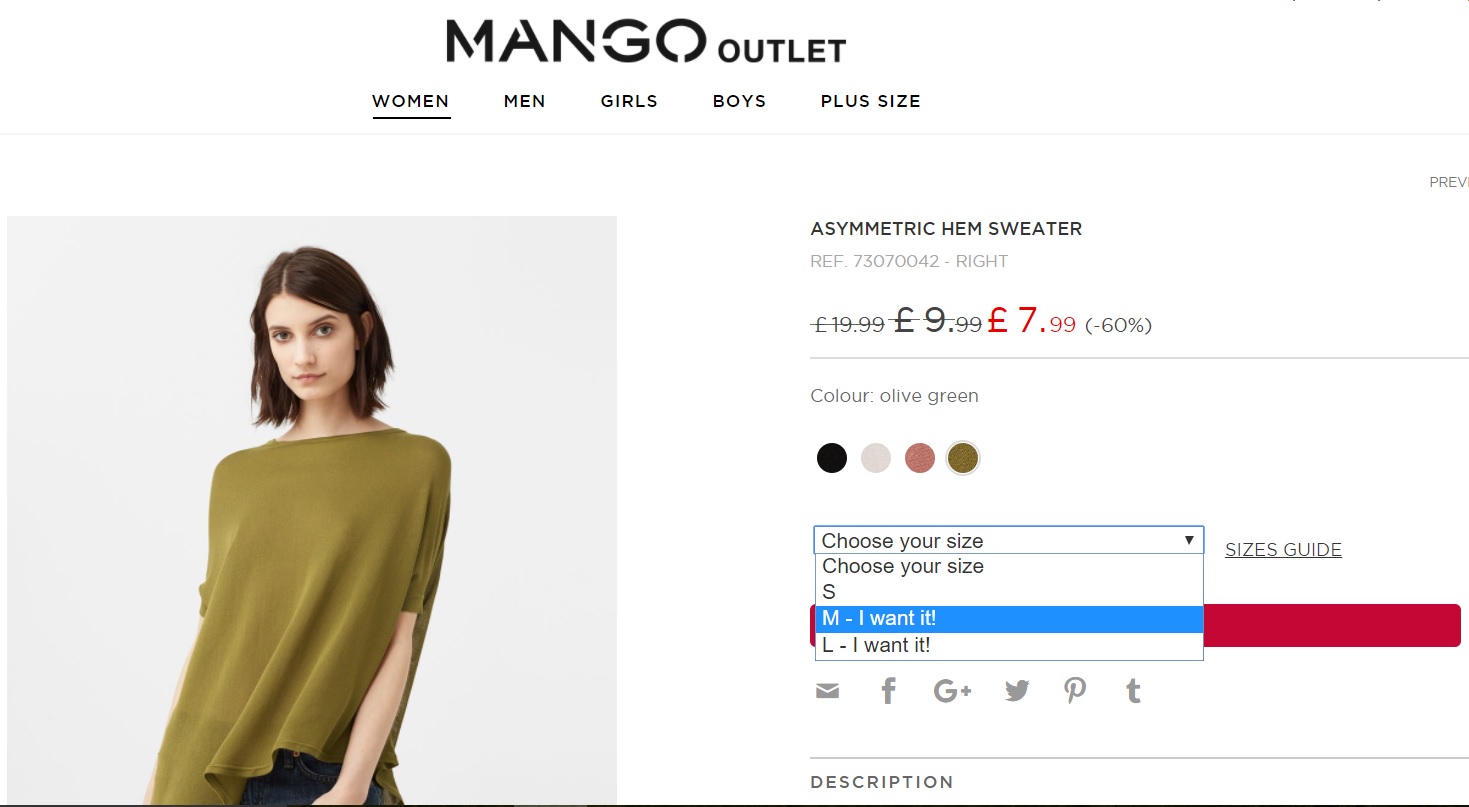
A busy promo calendar
If you want to speed things up and shorten the time between orders (TBO), your promotions should be more dynamic. If all you do is Christmas, spring sale, 4th of July sale and back to school, you can’t expect much buzz.
Find out your TBO with our free calculator
Instead, spice thing up. Different groups of customers like different types of promos so covering more will get you more results.
Only by looking at March in the calendar, you can have a International Women’s Day, First Day of Spring, St. Patrick’s, Easter, and World Wildlife Day specials! Not counting all the other niche promos you could do based on customer behavior.
Surprises in the order package
We mean good surprises.
These are little things to show you humanness and gratefulness to your customers so they feel good about giving you repeat business. It doesn’t have to be just a handwritten note, that’s overused.
It can be:
- something useful like a book mark with a new book (more ideas for package inserts)
- a fun little thing like a sleeping mask (to sleep off hangover) with an order of a wedding guest attire
- samples of a new product (this can get you new orders as well)
Minimize returns
They’re nothing to worry about but they’re an unpleasant hassle for both you and the customer so they should be avoided in order to keep the shopping experience spotless.
Related: Reduce product returns for clothing brands
How can you make sure clients get what they think they’re getting?
First, explain everything in the product descriptions – material, suitable purposes, maintenance and supplies needed, etc. so they know everything there is upfront. There’s no use of misleading people if they’re going to return the item later.
Second, your product pictures should show detail – back, front, special details, hems, labels, texture – anything that people look for when buying at a physical store should be visible on your site as well. Here’s a great guide to product photography for online stores.
And third, when selling clothes, make sizing understandable. That’s imperative. It’s best to work with a standard system like the US/ EU/ UK one and truly adhere to it. If not, list the measurements that correspond to your sizes in full so people can easily pick the right one for themselves.
Email marketing based on a person’s preference
We live in the time of personalization and tailored email marketing is the industry standard. But somehow even big retailers fail to do it properly.
For example, if someone has never bought any athleisure items from you but only work button up shirts, there’s no point in sending them your new sports collection.
You can’t make everybody buy all of your products so it’s smarter to give them what they want – only more often.
3. Increase the customer lifespan
Your entire relationship with a customer can be longer is you add steps to the customer lifecycle and work to fight the natural “slip away”.
Related: Lifecycle emails that drive CLV up
Very few shops sell products of vital importance so customers have to buy them and buy often. But people still get hooked on Apple products, right? They enjoy the experience that comes with buying those products and happily make Apple’s CLV huge.
A few ways to achieve that feeling and improve customer loyalty are:
Consistent quality
Customers are loyal as long as you don’t fail. After all, they pay to get a certain item. You can have the prettiest site and the best promotions, and if your product quality goes down, so will customer satisfaction.
They rarely forgive because they have other places to buy from. It’s up to you to deliver a great product every time and outshine the competition.
Serve them better with time
Customer service should get better as your relationship with a customer progresses. It’s true first impression matter a lot, but losing a long-time patron due to bad service is unacceptable.
They trust you repeatedly and so should you. All reward points don’t matter if those valuable customers feel mistreated and left behind.
Discount less
We’ve talked about how discounts devalue the brand before, but research now proves they’re bad for the bottom line in the long run.
Customers acquired with discounts tend to have a lower CLV since they view the brand as not worthy to pay in full for.
So don’t rely on promo codes alone to bring in new customers. Find such that will pay the full price.
Use the channels your customers like
Despite what’d be convenient for us as marketers, our customers are not all comfortable communicating over the same channels, say only FB messenger.
That’s why keeping an eye where your most important customers are and meeting them there is a good retention tactic. They’ll be comfortable to engage with your brand.
They respond well to monthly newsletters ? Ok. They like а confirmation call on the phone? Why not? They are eager to discuss related topics in a FB group? Make it happen.
Ask for feedback and resolve issues
It’s only logical to ask the opinion of repeat buyers – they know your brand better and have more to say. Plus, engaging them in the product development boosts brand affiliation.
Do it often, ask about new products and site redesigns, about alternative uses of products and user-generated content. The goal is to be always at the back of their minds.
What happens when you focus on optimizing CLV?
One example is Native, a natural deodorant brand that grew from 0 to $100 million within 3 years of launch.
Their tactics aimed at retention mainly. Sales to returning customers account for as much as 50% of all sales. Founder Moiz Ali does not hide that prioritizing repeat business and CLV drove the brand’s exponential growth and helped seal the great acquisition deal with Procter & Gamble.
Build and grow your ecommerce brand
Metrilo’s mission is to help you build your ecommerce brand and win your place in the customer’s heart. We share what we learn from our daily work with product innovators and founders here. Subscribe to our weekly newsletter to get the freshest lessons and conquer your niche.
We promise, no spam.
Thank you for subscribing!
See you soon :-)
